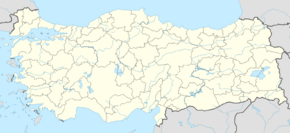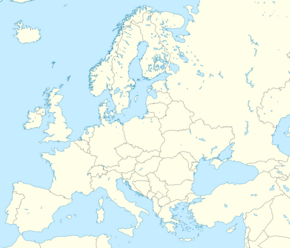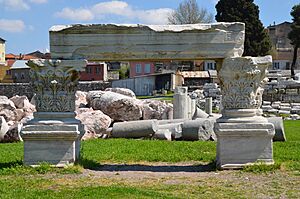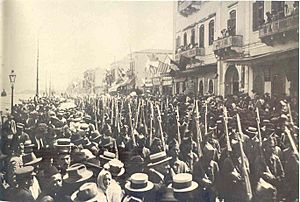Smyrna facts for kids
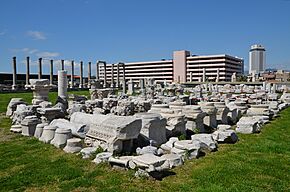
The Agora of Smyrna (columns of the western stoa)
|
|
| Location | İzmir, İzmir Province, Turkey |
|---|---|
| Region | Ionia |
| Coordinates | 38°25′7″N 27°8′21″E / 38.41861°N 27.13917°E |
| Type | Settlement |
Smyrna was an Ancient Greek city. It was located in a very important spot on the Aegean coast of Anatolia. Smyrna grew to be very important. This was because it had a great port, was easy to defend, and had good connections to inland areas. Since about 1930, the city has been called İzmir.
Today, two parts of the ancient city are inside İzmir. The first part, called Old Smyrna, was likely started by local people. It became a major Greek settlement in western Anatolia during the Archaic Period. The second part, called Smyrna proper, was founded later. Its creation was inspired by Alexander the Great. This new city grew very large during the Roman Empire. Most of the ancient city's remains you see today are from the Roman time. Many of these were rebuilt after a big earthquake in 178 AD.
Old Smyrna was first settled around the 11th century BC. It was an Aeolian settlement. Later, the Ionians took it over and made it bigger. Smyrna proper was the new city. People moved there starting in the 4th century BC.
Contents
Where Was Ancient Smyrna Located?
Old Smyrna was on a small piece of land sticking out into the sea. This land was connected to the main land by a narrow strip. It was at the northeast corner of the inner Gulf of İzmir. It sat at the edge of a rich plain and at the foot of Mount Yamanlar. This early settlement controlled the gulf. Today, this old site is called Bayraklı Höyüğü. It is about 700 meters (766 yards) inland. You can find it in the Tepekule neighborhood of Bayraklı.
The "New" Smyrna grew at the same time. It was built on the slopes of Mount Pagos, which is now called Kadifekale. It also spread along the coast. There was a small bay there until the 1700s.
The main part of the later Hellenistic and early Roman Smyrna is now the large İzmir Agora Open Air Museum. Experts are still studying both the old and new city sites. This work has been going on since 1997 for Old Smyrna. For the Classical Period city, it started in 2002. The İzmir Archaeology Museum and the Metropolitan Municipality of İzmir work together on this.
Smyrna was located at the mouth of the small Hermus river. It was also at the end of a deep arm of the sea called Smyrnaeus Sinus. This arm reached far inland. This allowed Greek trading ships to sail deep into Lydia. This made Smyrna a key part of a trade route between Anatolia and the Aegean Sea. In the 7th century BC, Smyrna became very powerful and splendid.
One of the main trade routes across Anatolia went down the Hermus valley. It passed Sardis, then went south of Mount Sipylus. It crossed a low pass into the small valley where Smyrna is, between mountains and the sea. Other cities like Miletus and later Ephesus were at the sea end of another big trade route. For a while, they competed with Smyrna. But their harbors filled up with mud, and then Smyrna had no rivals.
The Meles River flowed by Smyrna. It was famous in stories and was even worshipped. Many old stories connect Homer, the famous poet, with Smyrna and the Meles river. His face was often shown on Smyrna's coins. One type of coin is even called "Homerian" by coin experts. Homer was sometimes called Melesigenes, meaning "born of Meles." People would point to a cave near the river's source where he supposedly wrote poems. His temple, the Homereum, stood on the river banks. The Meles river flowed steadily all year. It was also short, starting and ending near the city.
A Look at Smyrna's Past

The Hellenistic Period: A New Beginning
Alexander the Great had the idea to rebuild the Greek city. This plan was carried out by Antigonus (316–301 BC) and Lysimachus (301 BC—281 BC). They made the city bigger and stronger. The old city's ruined fortress, or "acropolis," was on a steep peak. This peak was about 381 meters (1250 feet) high. It overlooked the northeast end of the gulf. Modern İzmir was built on top of this later Hellenistic city. It was partly on the slopes of a rounded hill called Pagos by the Greeks. It was also partly on the low land between the hill and the sea. People in ancient times often praised the beauty of the Hellenistic city. It was built on low ground and rose up the hillside in layers. This beauty was even shown on its coins.
Smyrna was closed off on the west by a hill now called Deirmen Tepe. This hill has the ruins of a temple at its top. The city walls built by Lysimachus went over the top of this hill. The acropolis was at the top of Pagus. Between these two, the road from Ephesus entered the city. This was through the Ephesian gate. Near this gate was a gymnasium, a place for exercise and learning. Closer to the acropolis, you can still see the shape of the stadium. The theater was on the north slopes of Pagus.
Smyrna had two harbors. The outer harbor was just the open gulf. The inner harbor was a small basin. It had a narrow entrance. This inner harbor was partly filled up by Tamerlane in 1402.
The streets in Smyrna were wide, well-paved, and laid out in straight lines. Many were named after temples. The main street, called the Golden Street, ran across the city from west to east. It likely started from the temple of Zeus Akraios on the west slope of Pagus. It then went around the lower slopes of Pagus. This was like a necklace on a statue, as one ancient speaker described it. It went towards Tepecik outside the city on the east. There, probably stood the temple of Cybele. She was worshipped as Meter Sipylene, the city's protector. Her name came from nearby Mount Sipylus. This mountain bordered the valley behind the city. The flat land towards the sea was too low to drain well. So, when it rained, the streets in the lower town would get very muddy and watery.
Towards the end of the Hellenistic period, in 197 BC, Smyrna suddenly broke away from King Eumenes of Pergamum. It asked Rome for help. Since Rome and Smyrna had no ties before this, Smyrna created a special worship of Rome. This was to build a connection. This worship eventually spread across the Roman Empire. From 195 BC, the city of Rome began to be seen as a goddess, called Roma. So, the people of Smyrna can be seen as the first to create the goddess Roma.
In 133 BC, the last king of Attalid, Attalus III, died without children. His will gave his entire kingdom, including Smyrna, to the Romans. The Romans made it into the Roman province of Asia. Pergamum became the capital. As a major seaport, Smyrna became a leading city in this new province.
Roman and Byzantine Times: A City of Faith and Change
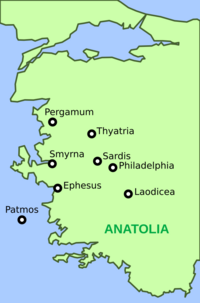
Smyrna was one of the most important cities in Roman Asia. It competed with Ephesus and Pergamum for the title "First City of Asia."
A Christian church and a bishopric (area led by a bishop) were in Smyrna from very early times. They likely started from the large Jewish community there. Smyrna was one of the seven churches mentioned in the Book of Revelation. Saint Ignatius of Antioch visited Smyrna. He later wrote letters to its bishop, Polycarp. In 153 AD, a crowd of Jewish and pagan people helped in the death of Polycarp. Saint Irenaeus, who heard Polycarp speak as a boy, was probably from Smyrna. Another famous person from that time was Aelius Aristides.
After a powerful earthquake in 178 AD, Smyrna was rebuilt during the Roman period. This happened under the emperor Marcus Aurelius. Aelius Aristides wrote a letter to Marcus Aurelius and his son Commodus. He asked them to be the new founders of the city. A statue of the emperor's wife Faustina on an arch confirms this.
When Constantinople became the capital of the Roman Empire, trade between Anatolia and the West became less important. Because of this, Smyrna declined.
The Seljuk commander Tzachas took Smyrna in 1084. He used it as a base for attacks by sea. But the general John Doukas took the city back.
The city was attacked many times by the Turks. It was in ruins when the Nicaean emperor John III Doukas Vatatzes rebuilt it around 1222.
Ottoman Period: A Diverse City

When Ibn Batuta visited, Smyrna was still mostly in ruins. This was around 1330. The leader of the Beylik of Aydın had conquered it. He made his son, Umur, the governor. Smyrna became the main port for this area.
During the Smyrniote Crusade in 1344, Christian forces captured the harbor and city from the Turks. These forces included the Knights Hospitallers, Venice, the Papal States, and Cyprus. They held the city for almost 60 years. The fortress fell in 1348, and the governor Umur Baha ad-Din Ghazi died.
In 1402, Tamerlane attacked the town. He killed almost all the people living there. His control was only for a short time. Smyrna was taken back by the Turks under the Aydın dynasty. After 1425, it became part of the Ottoman Empire.
Greek influence was very strong in the area. The Turks even called it "Smyrna of the infidels" (Gavur İzmir). Turkish records say this name appeared in the 14th century. At that time, two parts of the city were controlled by different groups. The upper part was Muslim, and the lower part was Christian.
Armenians, along with Greeks, played a big part in the city's growth. This was especially true during the age of exploration. Armenians became very important in trade. They had trade routes that went from the Far East to Europe. One very important product they traded was Iranian silk. The Shah Abbas of Iran gave them control over this trade in the 17th century.
Armenians traded Iranian silk with European and Greek merchants in Smyrna. This trade made the Armenians very wealthy. Besides trade, Armenians also worked in manufacturing, banking, and other productive jobs.
In the late 1800s and early 1900s, Smyrna was a key financial and cultural center for Greeks. Out of 391 factories, 322 belonged to local Greeks. Three of its nine banks were supported by Greek money. Education was also mostly run by local Greek communities. They had 67 schools for boys and 4 for girls. The Ottomans still controlled the area. The only exception was from 1919 to 1922. During this time, the city was given to Greece by the Treaty of Sèvres.
The most important Greek school in the region was the Evangelical School of Smyrna. It operated from 1733 to 1922.
After World War I: The End of an Era
After World War I, Greece took control of Smyrna on May 15, 1919. They set up a military government. The Greek leader Venizelos wanted to make Smyrna part of Greece. He seemed to achieve this goal in the Treaty of Sèvres, signed on August 10, 1920. However, this treaty was never fully approved by all countries. The Treaty of Peace of Lausanne replaced it.
The Greek control of Smyrna ended when the Turkish army of Kemal Atatürk entered the city. This happened on September 9, 1922, at the end of the Greco-Turkish War (1919–1922). Soon after, a huge fire started in the Greek and Armenian parts of the city. This was on September 13, 1922. It is known as the Great Fire of Smyrna. The number of people who died is thought to be between 10,000 and 100,000.
The Agora: A City's Heart
The remains of Smyrna's ancient agora are now the İzmir Agora Museum. This is in İzmir's Namazgah area. People in the city often just call it "Agora".
It was located on the northern slopes of the Pagos hills. This was the main place for business, law, and politics in the ancient city. It was also a center for art and teaching.
The İzmir Agora Open Air Museum has five parts. These include the agora area itself, the base of the northern basilica gate, the stoa (a covered walkway), and the ancient shopping center.
The agora of Smyrna was built during the Hellenistic era.
Digging Up the Past: Excavations
People started exploring Smyrna in the 1800s. A German official in İzmir even bought land around the ancient theater in 1917 to start digging. But the first real scientific digs began in 1927. Most discoveries were made between 1931 and 1942. This was done by German archaeologist Rudolf Naumann and Selâhattin Kantar. Kantar was the director of the İzmir and Ephesus museums. They found a three-story, rectangular building. It had stairs at the front. It was built on columns and arches around a large courtyard.
New digs in the agora started in 1996. They have continued since 2002. The Metropolitan Municipality of İzmir helps pay for these digs. A primary school next to the agora had burned down in 1980. It was not rebuilt. Instead, its space was added to the historical site. The agora area grew to 16,590 square meters (178,573 square feet). This allowed them to explore an area that had not been dug before. The archaeologists and local officials are also looking at a nearby multi-storey car park. They know it covers a big part of the ancient settlement. During current repairs, old concrete fixes are being slowly replaced with marble.
The new digs have found the agora's northern gate. Experts believe that carved figures of the goddess Hestia found here were part of the Zeus altar found in earlier digs. Statues of the gods Hermes, Dionysos, Eros, and Heracles have also been found. Many other statues, heads, carvings, small figures, and monuments of people and animals have been found too. These are made of marble, stone, bone, glass, metal, and clay. Writings found here list the people who helped Smyrna after the 178 AD earthquake.
Smyrna's Economy
In the early 1900s, Smyrna had many mills that made thread. By 1920, there were two factories in Smyrna that dyed yarn. British companies owned these. They employed over 60,000 people. At this time, there was also a French-owned cotton spinning mill. The city also made soap from leftover olive oil. An ironworks, also owned by the British, made tools and equipment. These tools were used to get tannin from valonia oak trees. By 1920, the ironwork was sending out 5,000 tons of products each year. The city also made wooden boxes. These boxes were used to store figs and raisins. The wood for the boxes came from Austria and Romania.
Places Named After Smyrna
Several cities in America are named after Smyrna. These include Smyrna, Georgia; Smyrna, Tennessee; Smyrna, North Carolina; Smyrna, South Carolina; Smyrna, Delaware; Smyrna, Michigan; Smyrna, Maine and New Smyrna Beach, Florida.
See also
- List of ancient Greek cities
- Ionia
- Nea Smyrni
- New Smyrna Beach, Florida
- On the Quai at Smyrna (Hemingway story)
- Yeşilova Höyük


